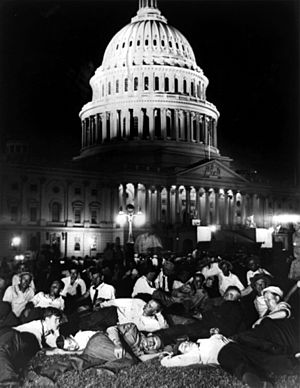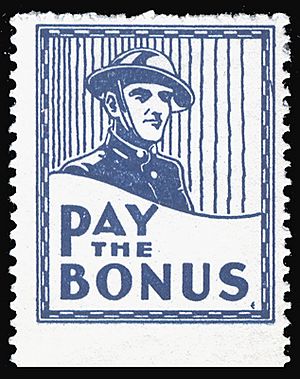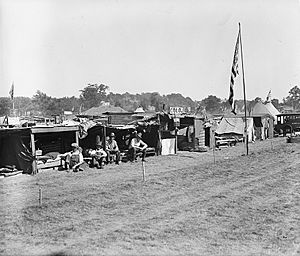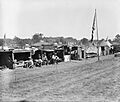Bonus Army facts for kids
Quick facts for kids Bonus Army |
|||
|---|---|---|---|

Bonus Army marchers (left) clash with the police.
|
|||
| Date | July 28, 1932 | ||
| Location | |||
| Caused by | Impoverishment of WWI veterans from the Depression | ||
| Resulted in | Demonstrators dispersed, demands rejected, Herbert Hoover loses 1932 presidential election | ||
| Parties to the civil conflict | |||
|
|||
| Lead figures | |||
|
|||
| Number | |||
|
|||
| Casualties | |||
|
|||
The Bonus Army was a large group of people, mostly World War I veterans, who gathered in Washington, D.C. in 1932. They came to ask for money they felt they were owed for their service in the war. These veterans had been promised a "bonus" payment, but they couldn't get it until 1945. Many of them were struggling because of the Great Depression, a time when many people lost their jobs and money.
The group called themselves the Bonus Expeditionary Force (B.E.F.). This name was a nod to the American soldiers who fought in World War I. News reporters often called them the "Bonus Army" or "Bonus Marchers." Their leader was Walter W. Waters, a former sergeant. They wanted their bonus money right away to help their families.
On July 28, 1932, the U.S. government ordered the veterans to leave. When police tried to remove them, two veterans were hurt and later died. President Herbert Hoover then sent the U.S. Army to clear out the marchers' camps. General Douglas MacArthur led the soldiers, who used cavalry, infantry, and even tanks. The Bonus Army members, including their wives and children, were forced out, and their shelters were burned.
A smaller march happened in 1933 when Franklin D. Roosevelt became president. This time, the government offered jobs with the Civilian Conservation Corps (CCC). Most veterans accepted these jobs. In 1936, Congress finally approved paying the veterans their bonus money early, even though President Roosevelt had disagreed at first.
Contents
Why Did Soldiers Get Bonuses?
Giving bonuses to soldiers after a war started a long time ago, back in 1776. It was a way to make up for the lower pay soldiers received compared to what they could have earned in civilian jobs. The idea came from England, where they helped injured veterans and gave bonuses to soldiers.
In 1776, the first national law for pensions (regular payments) was passed for disabled veterans. Later, during the American Revolutionary War, George Washington pushed for more benefits. This was because many soldiers were leaving the army.
After the Revolutionary War, many soldiers were sent home. In 1783, hundreds of veterans marched on Philadelphia, which was the nation's capital at the time. They surrounded the building where Congress met, demanding their back pay. Congress had to leave the city. Over time, laws were passed to give pensions and bonuses, even to widows of soldiers.
Before World War I, soldiers often received land and money as a bonus. For example, a private in the Continental Army might get 100 acres of land and $80. By 1860, so much land had been given out that the program stopped. It was replaced with a cash-only system. After World War I, veterans only received a small $60 bonus. This led to groups like the American Legion pushing for more.
In 1924, President Calvin Coolidge did not want to approve a bill that would give more bonuses to World War I veterans. He said that "patriotism... bought and paid for is not patriotism." But Congress disagreed and passed the law anyway. This law, called the World War Adjusted Compensation Act, gave veterans a dollar for each day they served in the U.S., up to $500. They got $1.25 for each day they served overseas, up to $625. They had already received $60 when they left the army, so that amount was subtracted.
Most of this money was given as "Certificates of Service" that would mature in 20 years, meaning veterans couldn't get the cash until 1945. There were over 3.6 million of these certificates, worth billions of dollars. A special fund was set up to pay for them in 1945. Veterans could borrow some money against their certificates. In 1931, during the Great Depression, they could borrow up to half the value. Many people in Congress wanted to pay the bonuses early. However, President Hoover and other leaders thought it would cost too much and slow down the country's recovery.
Life in the Bonus Army Camps
Most of the Bonus Army members set up camp in a place called "Hooverville" on the Anacostia Flats in Washington. This was a swampy area away from the main government buildings. Other veterans stayed closer to the city center in old, partly destroyed buildings. Even though camping on the Anacostia Flats was against the law, the police chief, Pelham D. Glassford, quietly allowed it.
The camp was located in an area that was historically African American. There were tennis courts and a baseball field nearby, which the children in the camp used. The veterans built their shelters from whatever they could find, like old wood, boxes, and scrap metal. The camp was nicknamed Camp Marks, after a friendly police captain.
The veterans managed Camp Marks very well. They created streets, built bathrooms, and even had their own police force. They held daily parades. It became a lively community with a religious tent and a Salvation Army library. In the library, marchers could write letters home. To live in the camps, veterans had to register and prove they had served honorably. Police Superintendent Glassford worked with the camp leaders to provide food and supplies.
On June 15, 1932, the House of Representatives voted to pay the World War I veterans their bonus money early. Over 6,000 marchers gathered at the U.S. Capitol on June 17 as the Senate voted on the bill. Sadly for the veterans, the bill was defeated.
The Army Steps In
After the bill was defeated, the government wanted the Bonus Army to leave. On July 28, 1932, President Hoover ordered the U.S. Army to remove the marchers from government property. General Douglas MacArthur, the Army Chief of Staff, was put in charge. He gathered soldiers, including cavalry led by Major George S. Patton, and tanks.
At 4:45 PM, the soldiers marched down Pennsylvania Avenue. Thousands of people watched. The Bonus Marchers thought the troops were marching to honor them and cheered. But then, Major Patton ordered the cavalry to charge. Spectators began to yell, "Shame! Shame!"
After the cavalry, infantry soldiers with bayonets (knives attached to rifles) and tear gas entered the camps. They forced the veterans, their families, and others to leave. The veterans fled across the Anacostia River to their main camp. President Hoover then ordered the army to stop. However, General MacArthur ignored this order. He continued the attack, saying that the Bonus March was an attempt to overthrow the U.S. government.
During the attack, 55 veterans were injured, and 135 were arrested. A veteran's wife had a miscarriage. A 12-week-old baby died in the hospital after being caught in the tear gas. A government investigation said the baby died of an illness, but a hospital spokesperson said the tear gas "didn't do it any good."
Major Dwight D. Eisenhower, who later became president, was one of MacArthur's assistants. He thought it was wrong for the Army's top officer to lead an action against American war veterans. He strongly advised MacArthur not to take a public role in the operation.
MacArthur ordered his troops to cross the Anacostia bridge and clear out the camp there. The shacks in the Anacostia Camp were then set on fire. It's not completely clear who started the fires.
What Happened Next?
The Bonus Army incident was a disaster for President Hoover. It made many people unhappy with him and is seen as a reason he lost the 1932 presidential election to Franklin D. Roosevelt.
Police Superintendent Glassford was upset that the Army got involved. He believed the police could have handled the situation. He soon resigned from his job.
In 1933, a movie called Gabriel Over the White House was released. It showed a fictional president who chose not to use the military against unemployed marchers. Instead, he created an "Army of Construction" to work on public projects. First Lady Eleanor Roosevelt thought the movie's way of treating veterans was much better than Hoover's.
During his 1932 campaign, Roosevelt had also been against paying the bonus early. But when a second bonus march happened in 1933, Roosevelt handled it differently. His administration set up a special camp for the marchers at Fort Hunt, Virginia. They provided food, transportation, and entertainment.
President Roosevelt's wife, Eleanor, even visited the camp by herself. She ate lunch with the veterans and listened to their songs. She talked about her own memories of World War I. She offered them jobs in the new Civilian Conservation Corps (CCC). One veteran famously said, "Hoover sent the army, Roosevelt sent his wife." Eleanor Roosevelt later told reporters that the marchers were polite and that she felt comfortable with them, even though some critics called them communists or criminals.
In May 1933, Roosevelt allowed 25,000 veterans to join the CCC. This was special because usually, only unmarried men under 25 could join. Finally, in 1936, Congress passed a law to pay the $2 billion in World War I bonuses immediately. They even voted to override President Roosevelt's veto, meaning they passed the law despite his disagreement.
Images for kids









